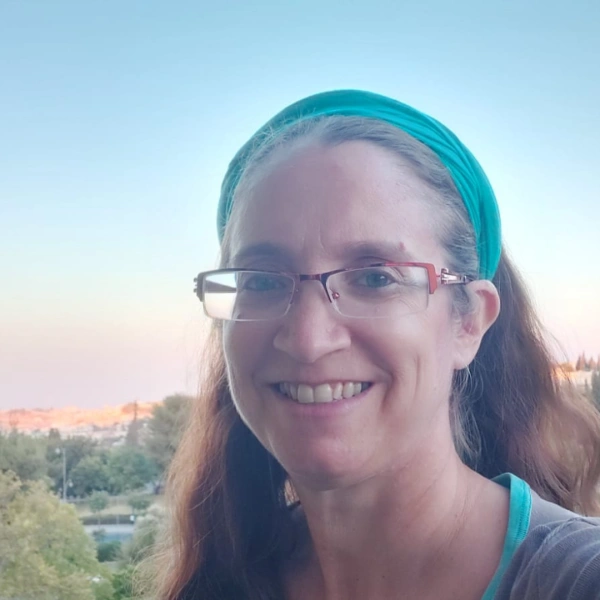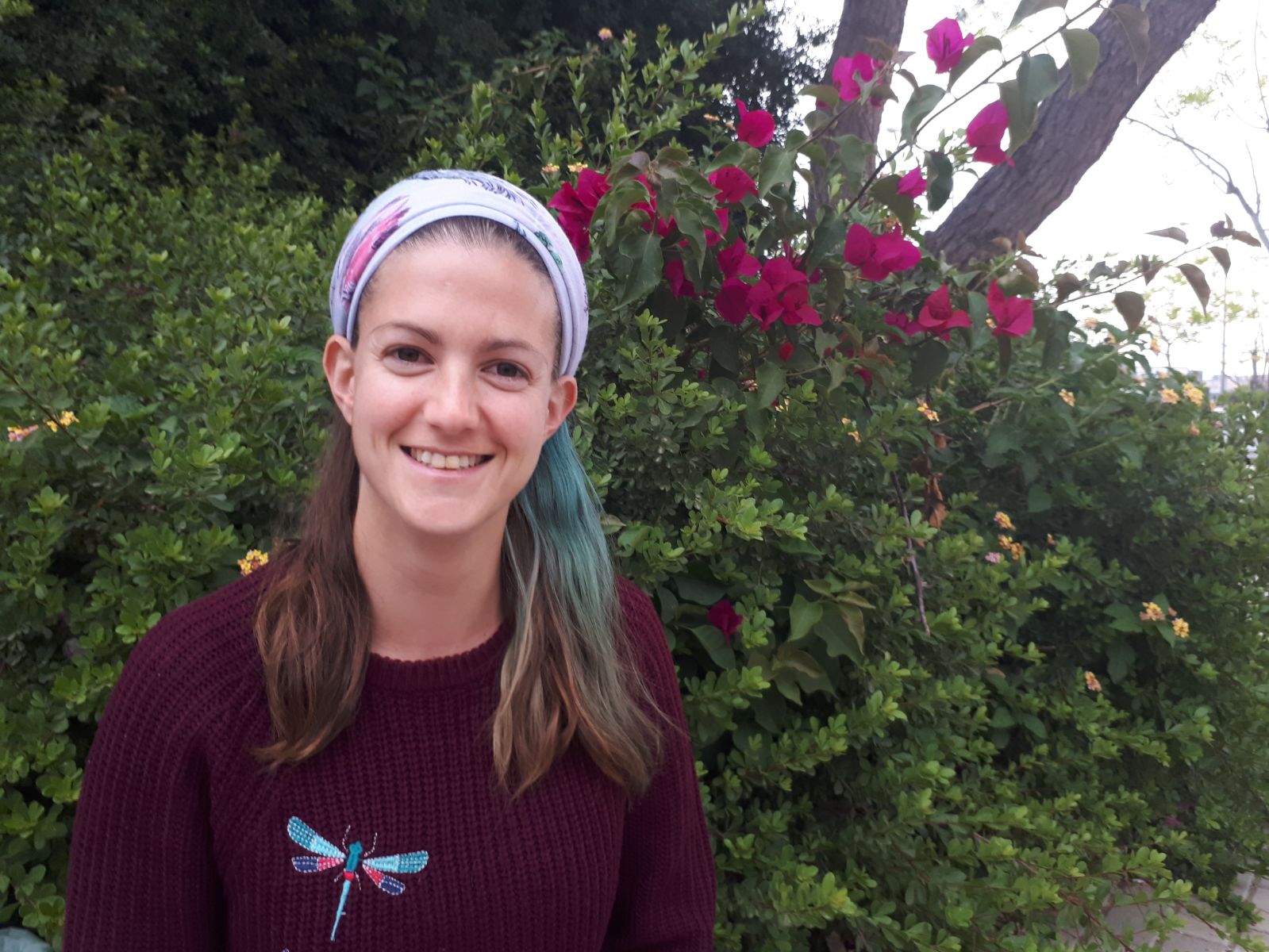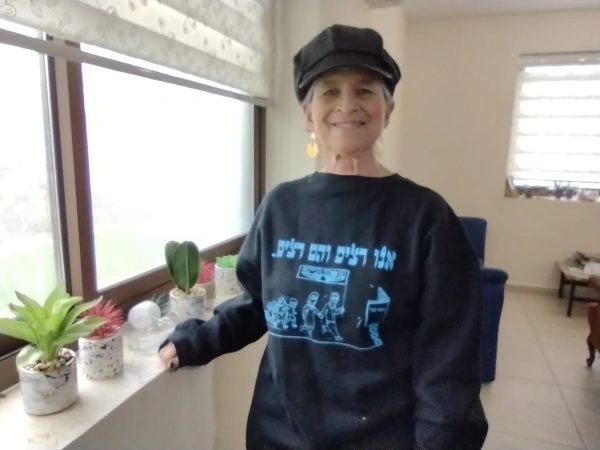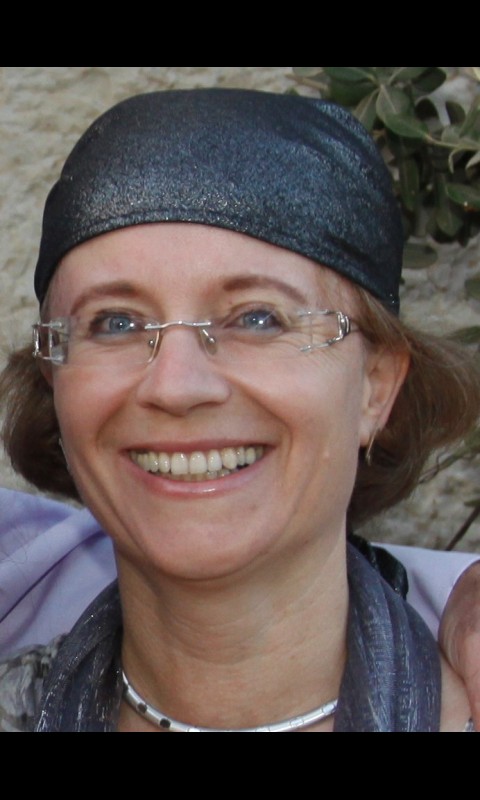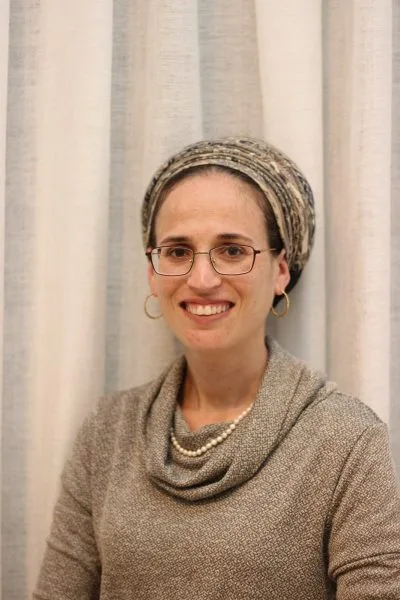הגמרא ממשיכה לדרוש גם פסוקים על המאבק בין יעקב למלאך ובעקבות זה מתחיל גם לדרוש בשמונה אופנים שונים את חלומו של שר המשקים. הגמרא חוזרת לדון פרטי דיני גיד הנשה – למה לא נוהג בעוף? איזה חלק בגיד אסור – הגיד עצמו או הקנוקנות היוצאות ממנו?
לימוד השבוע מוקדש ע”י טינה לם לע”נ יצחק מאיר בן הרב צבי אריה ואסתר בתיה.
רוצים להקדיש למידה? התחל כאן:
לימוד השבוע מוקדש ע”י טינה לם לע”נ יצחק מאיר בן הרב צבי אריה ואסתר בתיה.
העמקה
רוצה להבין מה באמת קורה מתחת לפני השטח של הסוגיה?
שיעורים, פודקאסטים והרחבות של מיטב המורות שלנו יפתחו לך עוד זוויות וכיווני חשיבה.
חדשה בלימוד הגמרא?
זה הדף הראשון שלך? איזו התרגשות עצומה! יש לנו בדיוק את התכנים והכלים שיעזרו לך לעשות את הצעדים הראשונים ללמידה בקצב וברמה שלך, כך תוכלי להרגיש בנוח גם בתוך הסוגיות המורכבות ומאתגרות.
פסיפס הלומדות שלנו
גלי את קהילת הלומדות שלנו, מגוון נשים, רקעים וסיפורים. כולן חלק מתנועה ומסע מרגש ועוצמתי.
חולין צב
ברוך אופנים הוא דאמרי ליה ואיבעית אימא כיון דאתיהיב רשותא אתיהיב
The Gemara answers that it is the ofanim who say the verse: “Blessed be the glory of the Lord from His place,” as the next verse mentions “the noise of the ofanim” (Ezekiel 3:13), and Rav Ḥanina’s statement citing Rav was referring not to ofanim but to ministering angels. And if you wish, say that once permission has been given to them to mention the name of God after three words when they say: “Holy, holy, holy,” permission is also given to them to mention the name of God again while praising Him even after fewer than three words.
(הושע יב, ה) וישר אל מלאך ויוכל בכה ויתחנן לו איני יודע מי נעשה שר למי כשהוא אומר (בראשית לב, כט) כי שרית עם אלהים הוי אומר יעקב נעשה שר למלאך
The Gemara continues to discuss Jacob wrestling with the angel. The prophet states: “So he strove [vayyasar] with an angel, and prevailed; he wept, and made supplication to him; at Beth El he would find him, and there he would speak with us” (Hosea 12:5). From this verse I do not know who became master [sar], i.e., was victorious, over whom. When another verse states: “And he said: Your name shall no longer be called Jacob, but Israel; for you have striven with angels and with men, and have prevailed” (Genesis 32:29), you must say that Jacob became master over the angel.
בכה ויתחנן לו איני יודע מי בכה למי כשהוא אומר ויאמר שלחני הוי אומר מלאך בכה ליעקב
The verse in Hosea states: “He wept, and made supplication to him.” From this verse I do not know who cried to whom. When another verse states: “And he said: Let me go, for the dawn has risen” (Genesis 32:27), you must say that the angel cried to Jacob.
כי שרית [עם אלהים ועם אנשים] אמר רבה רמז רמז לו שעתידים שני שרים לצאת ממנו ראש גולה שבבבל ונשיא שבארץ ישראל מכאן רמז לו גלות
The verse states: “And he said: Your name shall no longer be called Jacob, but Israel; for you have striven with angels [elohim] and with men, and have prevailed” (Genesis 32:29). Rabba says: The angel intimated to Jacob that in the future two princes would emerge from him: They are the Exilarch who is in Babylonia and the Nasi who is in Eretz Yisrael. And from here he also intimated to Jacob that there would be an exile.
(בראשית מ, י) ובגפן שלשה שריגים אמר רב חייא בר אבא אמר רב אלו ג’ שרי גאים היוצאים מישראל בכל דור ודור פעמים ששנים כאן ואחד בארץ ישראל פעמים ששנים בארץ ישראל ואחד כאן יהיבו רבנן עינייהו ברבנא עוקבא ורבנא נחמיה בני ברתיה דרב
Similarly, with regard to the dream of Pharaoh’s butler, the verse states: “And in the vine were three branches [sarigim]; and as it was budding, its blossoms shot forth, and its clusters brought forth ripe grapes” (Genesis 40:10). Rav Ḥiyya bar Abba says that Rav says: These three branches refer to the three proud princes [sarei ge’im] who emerge from the Jewish people in each and every generation. There are times when two are here in Babylonia and one is in Eretz Yisrael, and there are times when two are in Eretz Yisrael and one is here in Babylonia. When this was stated in the study hall, the Sages present turned their eyes toward Rabbana Ukva and Rabbana Neḥemya, the sons of the daughter of Rav, who were from the family of the Exilarch and were two leaders of the generation who resided in Babylonia.
רבא אמר אלו שלשה שרי גוים שמלמדים זכות על ישראל בכל דור ודור
Rava says a different explanation of the verse: These three branches [sarigim] are the three ministering angels appointed to oversee the gentiles [sarei goyim], who plead in favor of the Jewish people in each and every generation.
תניא רבי אליעזר אומר גפן זה העולם שלשה שריגים זה אברהם יצחק ויעקב והיא כפורחת עלתה נצה אלו האמהות הבשילו אשכלותיה ענבים אלו השבטים
It is taught in a baraita: Rabbi Eliezer says an alternate interpretation of the verse. “Vine”; this is a reference to the world. “Three branches”; this is a reference to Abraham, Isaac, and Jacob. “And as it was budding, its blossoms shot forth”; these are the matriarchs. “And its clusters brought forth ripe grapes”; these are the twelve tribes, i.e., the twelve sons of Jacob.
אמר לו רבי יהושע וכי מראין לו לאדם מה שהיה והלא אין מראין לו לאדם אלא מה שעתיד להיות אלא גפן זה תורה שלשה שריגים אלו משה ואהרן ומרים והיא כפורחת עלתה נצה אלו סנהדרין הבשילו אשכלותיה ענבים אלו הצדיקים שבכל דור ודור
Rabbi Yehoshua said to him: But is a person shown in a dream what was in the past? Isn’t it true that one is shown only what will be in the future? Since the patriarchs, matriarchs, and sons of Jacob were all born prior to this dream, the dream was not alluding to them. Rather, the verse should be interpreted as follows: “Vine”; this is a reference to the Torah. “Three branches”; these are Moses, Aaron, and Miriam. “And as it was budding, its blossoms shot forth”; these are the members of the Sanhedrin. “And its clusters brought forth ripe grapes”; these are the righteous people who live in each and every generation.
אמר ר”ג עדיין צריכין אנו למודעי דמוקים ליה כוליה בחד מקום רבי אלעזר המודעי אומר גפן זה ירושלים שלשה שריגים זה מקדש מלך וכהן גדול והיא כפורחת עלתה נצה אלו פרחי כהונה הבשילו אשכלותיה ענבים אלו נסכים
Rabban Gamliel said: In order to understand this verse (Genesis 40:10) we still need the explanation of Rabbi Elazar HaModa’i, who is an expert in matters of aggada, as he interprets all of the phrases in the verse as referring to one location. Rabbi Elazar HaModa’i says: “Vine”; this is a reference to Jerusalem. “Three branches”; this is a reference to the Temple, the king and the High Priest. “And as it was budding [poraḥat], its blossoms shot forth”; these are the young priests [pirḥei khehunna]. “And its clusters brought forth ripe grapes”; these are the wine libations.
רבי יהושע בן לוי מוקים לה במתנות דאמר ר’ יהושע בן לוי גפן זו תורה שלשה שריגים זה באר עמוד ענן ומן והיא כפורחת עלתה נצה אלו הבכורים הבשילו אשכלותיה ענבים אלו נסכים
Rabbi Yehoshua ben Levi interprets it with reference to the gifts that God gave the Jewish people, as Rabbi Yehoshua ben Levi said: “Vine”; this is a reference to the Torah. “Three branches”; this is a reference to the miraculous items that accompanied the Jewish people in the wilderness and sustained and protected them: The well, the pillar of cloud, and the manna. “And as it was budding, its blossoms shot forth”; these are the first fruits that are brought to the Temple. “And its clusters brought forth ripe grapes”; these are the wine libations.
רבי ירמיה בר אבא אמר גפן אלו ישראל וכן הוא אומר (תהלים פ, ט) גפן ממצרים תסיע שלשה שריגים אלו שלשה רגלים שישראל עולין בהן בכל שנה ושנה והיא כפורחת עלתה נצה הגיע זמנן של ישראל לפרות ולרבות וכן הוא אומר (שמות א, ז) ובני ישראל פרו וישרצו
Rabbi Yirmeya bar Abba says: “Vine”; this is a reference to the Jewish people, and similarly another verse states: “You plucked up a vine out of Egypt; You drove out the nations and planted it” (Psalms 80:9). “Three branches”; these are the three pilgrimage Festivals, on which the Jewish people ascend to Jerusalem every year. “And as it was budding, its blossoms shot forth,” means that the time has arrived for the Jewish people to be fruitful and multiply, and similarly another verse states: “And the children of Israel were fruitful, and increased abundantly, and multiplied, and became exceeding mighty; and the land was filled with them” (Exodus 1:7).
עלתה נצה הגיע זמנן של ישראל ליגאל וכן הוא אומר (ישעיהו סג, ג) ויז נצחם על בגדי וכל מלבושי אגאלתי הבשילו אשכלותיה ענבים הגיע זמנה של מצרים לשתות כוס התרעלה
“Its blossoms [nitzah] shot forth” means that the time has arrived for the Jewish people to be redeemed. And similarly another verse states: “And their eternity [nitzḥam] is dashed against My garments, and I have redeemed all My raiment” (Isaiah 63:3). “And its clusters brought forth ripe grapes” means that the time has arrived for Egypt to drink the cup of fury, i.e., to receive its punishment.
והיינו דאמר רבא שלשה כוסות האמורות במצרים למה אחד ששתה בימי משה ואחד ששתה בימי פרעה נכה ואחד שעתידה לשתות עם כל העובדי כוכבים
And this is as Rava said: Why are there three cups stated with regard to Egypt in the dream of Pharaoh’s butler (see Genesis 40:11)? They are an allusion to three cups of misfortune that would later befall Egypt: One that Egypt drank in the days of Moses during the ten plagues and the Exodus; one that Egypt drank in the days of Pharaoh Nekho, the king of Egypt defeated by Nebuchadnezzar; and one that Egypt will drink in the future with all the other nations, when they are punished in the time of the Messiah.
אמר ליה רבי אבא לרבי ירמיה בר אבא כי דריש להו רב להני קראי באגדתא כוותך דריש להו
Rabbi Abba said to Rabbi Yirmeya bar Abba: When Rav interpreted these verses homiletically he interpreted them according to the way in which you have interpreted them, and not according to any of the other opinions cited above.
אמר רבי שמעון בן לקיש אומה זו כגפן נמשלה זמורות שבה אלו בעלי בתים אשכולות שבה אלו תלמידי חכמים עלין שבה אלו עמי הארץ קנוקנות שבה אלו ריקנים שבישראל
Similar to Rabbi Yirmeya bar Abba’s interpretation of the word vine as an allusion to the Jewish people, Rabbi Shimon ben Lakish says: This nation is likened to a vine. The branches of the vine support the clusters of grapes, the leaves, and the tendrils; these are represented among the Jewish people by the homeowners, who provide financial support for the entire nation. The clusters of grapes on the vine, these are the Torah scholars. The leaves on the vine, which protect the grapes, these are the ignoramuses, who protect the Torah scholars. The tendrils of the vine, which do not directly serve the grapes themselves, these are the empty ones of the Jewish people.
והיינו דשלחו מתם ליבעי רחמים איתכליא על עליא דאילמלא עליא לא מתקיימין איתכליא
And this is the meaning of the instruction that they sent from there, i.e., from Eretz Yisrael: Let the clusters of grapes pray for the leaves, as were it not for the leaves, the clusters of grapes would not survive.
(הושע ג, ב) ואכרה לי בחמשה עשר כסף א”ר יוחנן משום ר’ שמעון בן יהוצדק אין כירה אלא לשון מכירה שנאמר (בראשית נ, ה) בקברי אשר כריתי לי
§ The Gemara cites homiletical interpretations of other verses that pertain to the leaders of the Jewish people in Eretz Yisrael and Babylonia. The verse states: “So I bought her [va’ekkereha] to me for fifteen pieces of silver, and a ḥomer of barley, and a half-ḥomer of barley” (Hosea 3:2). Rabbi Yoḥanan says in the name of Rabbi Shimon ben Yehotzadak: The term kira, which forms the basis of the verb va’ekkereha, is nothing other than language referring to a sale [mekhira], as it is stated that Joseph said: “My father made me swear, saying: Lo, I die; in my grave that I have acquired [kariti] for me in the land of Canaan, there shall you bury me” (Genesis 50:5).
בחמשה עשר זה ט”ו בניסן שבו נגאלו ישראל ממצרים כסף אלו צדיקים וכן הוא אומר (משלי ז, כ) צרור הכסף לקח בידו
Rabbi Yoḥanan continues: “For fifteen pieces of silver”; this is a reference to the fifteenth of Nisan, the date on which the Jewish people were redeemed from Egypt. “Silver”; these are the righteous people. And similarly, another verse states: “He has taken the bag of silver with him” (Proverbs 7:20), a reference to God taking the righteous away prior to the destruction of the First Temple (see Sanhedrin 96b).
חומר שעורים ולתך שעורים אלו מ”ה צדיקים שהעולם מתקיים בהם ואיני יודע אם שלשים כאן וט”ו בארץ ישראל ואם שלשים בארץ ישראל וט”ו כאן כשהוא אומר (זכריה יא, יג) ואקחה שלשים הכסף ואשליך אותו בית ה’ אל היוצר הוי אומר שלשים בארץ ישראל וט”ו כאן
The verse states: “A ḥomer of barley, and a half-ḥomer of barley.” A ḥomer equals thirty se’a, and a half-ḥomer equals fifteen se’a, totaling forty-five se’a; these are the forty-five righteous individuals in whose merit the world continues to exist. And although the verse alludes to the fact that thirty of these righteous individuals are in one place and fifteen are elsewhere, I do not know if thirty are here in Babylonia and fifteen are in Eretz Yisrael, or if thirty are in Eretz Yisrael and fifteen are here in Babylonia. When it says in a different verse: “And I took the thirty pieces of silver and cast them into the treasury, in the house of the Lord” (Zechariah 11:13), you must say that thirty of the righteous individuals are in Eretz Yisrael and fifteen are here in Babylonia.
אמר אביי ורובייהו משתכחי בבי כנישתא דתותי אפתא והיינו דכתיב (זכריה יא, יב) ואומר אליהם אם טוב בעיניכם הבו שכרי ואם לא חדלו וישקלו את שכרי שלשים כסף
Abaye said: And most of the fifteen righteous individuals in Babylonia are found in the synagogue under the upper room. And this is the meaning of that which is written: “And I said to them: If it is good in your eyes, give me my hire; and if not, refrain. And they weighed for my hire thirty pieces of silver” (Zechariah 11:12).
רבי יהודה אומר אלו שלשים צדיקי אומות העולם שאומות העולם מתקיימים עליהם עולא אמר אלו שלשים מצות שקבלו עליהם בני נח ואין מקיימין אלא שלשה אחת
Rabbi Yehuda says: These are the thirty righteous individuals among the nations of the world, in whose merit the nations of the world continue to exist. Ulla says: These are the thirty mitzvot that the descendants of Noah initially accepted upon themselves; but they fulfill only three of them. One of these three mitzvot is
שאין כותבין כתובה לזכרים ואחת שאין שוקלין בשר המת במקולין ואחת שמכבדין את התורה:
that they do not write a marriage contract for a wedding between two males; although they violate the prohibition against engaging in homosexuality, they are not so brazen as to write a marriage contract as for a regular marriage. And one of the three mitzvot is that although they are suspected of eating human beings, they do not weigh the flesh of the dead in butcher shops [bemakkulin] and sell it publicly; and one is that they honor the Torah.
ואינו נוהג בעוף: והא קא חזינן דאית ליה אית ליה ולא עגיל
§ The mishna teaches (89b) that the prohibition of eating the sciatic nerve does not apply to a bird due to the fact that the verse is referring to the sciatic nerve as being “upon the spoon of the thigh” (Genesis 32:33), and a bird has no spoon of the thigh. The Gemara challenges: But we see that it does have a protrusion of flesh on its thigh. The Gemara answers: It has a protrusion, but that protrusion is not rounded.
בעי רבי ירמיה אית ליה לעוף ועגיל אית ליה לבהמה ולא עגיל מאי בתר דידיה אזלינן או בתר מיניה אזלינן תיקו:
Rabbi Yirmeya raises a dilemma: If a bird has a protrusion on its thigh bone and it is rounded, or an animal has a protrusion on its thigh bone but it is not rounded, what is the halakha? Do we follow it, i.e., does the status of the sciatic nerve depend upon the physical properties of each particular animal, or do we follow its species, so that the sciatic nerve of an animal is always forbidden and that of a bird is always permitted? The Gemara responds: The question shall stand unresolved.
ונוהג בשליל: אמר שמואל וחלבו מותר לדברי הכל
§ The mishna states that the prohibition of the sciatic nerve applies to a late-term animal fetus in the womb. Rabbi Yehuda says: It does not apply to a fetus; and its fat is permitted. Shmuel says: When the mishna states: And its fat is permitted, that is according to everyone.
חלבו דמאי אילימא דשליל והא מיפלג פליגי ביה דתניא נוהג בשליל וחלבו אסור דברי רבי מאיר רבי יהודה אומר אינו נוהג בשליל וחלבו מותר
The Gemara asks: The fat of what? If we say that it is referring to the fat of a fetus, don’t the tanna’im disagree about it, as it is taught in a baraita: The prohibition of the sciatic nerve applies to a late-term fetus, and its fat is prohibited; this is the statement of Rabbi Meir. Rabbi Yehuda says that the prohibition of the sciatic nerve does not apply to a late-term fetus, and its fat is permitted.
ואמר ר’ אלעזר אמר ר’ אושעיא מחלוקת בבן תשעה חי והלך ר”מ לשיטתו ורבי יהודה לשיטתו
And Rabbi Elazar says that Rabbi Oshaya says in explanation of the baraita: This dispute applies to a nine-month-old, i.e., a full-term, fetus that remains alive after its mother has been slaughtered. And Rabbi Meir followed his general opinion in this regard (see 74a), that this fetus is considered a live animal independent of its mother. Consequently, it must undergo ritual slaughter in order for its meat to be permitted for consumption, and its fats and sciatic nerve are forbidden like those of any other animal. And Rabbi Yehuda followed his general opinion that such a fetus is not considered a live animal but rather part of its mother. Consequently, it does not require ritual slaughter, and its fats and sciatic nerve are permitted.
ואלא חלבו דגיד הא מיפלג פליגי בה דתניא גיד הנשה מחטט אחריו בכל מקום שהוא וחותך שמנו מעיקרו דברי ר”מ רבי יהודה אומר גוממו עם השופי
But rather, perhaps Shmuel’s statement was said with regard to the fat of the sciatic nerve. But the tanna’im disagree about this case as well, as it is taught in a baraita: With regard to the sciatic nerve, one scrapes around it to remove it entirely in any place that it is found in the thigh, and one cuts out its fat from its source, i.e., even the fat that is embedded in the flesh; this is the statement of Rabbi Meir. Rabbi Yehuda says: One cuts out the nerve and fat so that they are level with the flesh [hashufi] of the thigh, but there is no need to scrape out the parts embedded in the flesh. Consequently, there is a dispute about the fat surrounding the sciatic nerve as well.
לעולם חלבו דגיד ומודה שמואל דלר”מ מדרבנן אסור דתניא ושמנו מותר וישראל קדושים נהגו בו איסור מאי לאו ר”מ היא דאמר מותר מן התורה ואסור מדרבנן
The Gemara answers: Actually, Shmuel was referring to the fat of the sciatic nerve, and Shmuel concedes that according to the opinion of Rabbi Meir the fat surrounding the sciatic nerve is forbidden by rabbinic law but permitted by Torah law. As it is taught in a baraita: Its fat is permitted by Torah law, but the Jewish people are holy and treated it as forbidden. The Gemara infers: What, is it not that this baraita is in accordance with the opinion of Rabbi Meir, who said that the fat is permitted by Torah law but forbidden by rabbinic law?
ממאי דילמא רבי יהודה היא אבל לרבי מאיר מדאורייתא נמי אסיר
The Gemara challenges this: From where can it be proven that this baraita is in accordance with the opinion of Rabbi Meir? Perhaps it is in accordance with the opinion of Rabbi Yehuda, but according to the opinion of Rabbi Meir it is even forbidden by Torah law.
לא ס”ד דתניא גיד הנשה מחטט אחריו בכל מקום שהוא ושמנו מותר מאן שמעת ליה דאית ליה חטיטה ר”מ וקאמר שמנו מותר
The Gemara rejects this challenge: It would not enter your mind that this baraita is in accordance with the opinion of Rabbi Yehuda, as it is taught in a baraita: With regard to the sciatic nerve, one scrapes around it to remove it entirely from any place that it is found in the thigh, and its fat is permitted. The Gemara explains: Whom have you heard who holds that scraping is required? It is Rabbi Meir. And the baraita states that its fat is permitted. Consequently, Rabbi Meir must hold that the fat surrounding the sciatic nerve is permitted by Torah law and forbidden by rabbinic law.
אמר רב יצחק בר שמואל בר מרתא אמר רב לא אסרה תורה אלא קנוקנות שבו עולא אמר עץ הוא והתורה חייבה עליו
§ With regard to the sciatic nerve Rav Yitzḥak bar Shmuel bar Marta says that Rav says: The Torah prohibited only its thin, tendril-like nerve fibers [kenokanot] that branch off and run alongside the sciatic nerve, under the flesh. By contrast, the sciatic nerve itself, which is inedible and has no flavor, is therefore considered like wood rather than food, and is not forbidden. Conversely, Ulla says: The sciatic nerve is inedible and has no flavor, like wood, but nevertheless the Torah rendered one liable for eating it.
אמר אביי כוותיה דעולא מסתברא דאמר רב ששת אמר רב אסי חוטין שבחלב אסורין ואין חייבין עליהן אלמא חלב אמר רחמנא ולא חוטין הכא נמי גיד אמר רחמנא ולא קנוקנות
Abaye said: It stands to reason that the halakha is in accordance with the opinion of Ulla, because Rav Sheshet said that Rav Asi said: The strands of veins that are in the forbidden fat are forbidden, but one is not liable for eating them. Apparently, when the Merciful One states in the Torah that it is prohibited to eat fat, the prohibition applies only to the fat itself but not to the strands of veins. Here also, the Merciful One states in the Torah that it is prohibited to eat the sciatic nerve, but that does not include the tendril-like nerve fibers.
גופא אמר רב ששת אמר רב אסי חוטין שבחלב אסורין ואין חייבין עליהן שבכוליא אסורין ואין חייבין עליהן לובן כוליא רבי ורבי חייא חד אסר וחד שרי
§ The Gemara now returns to the matter itself cited in the discussion above: Rav Sheshet said that Rav Asi said: The strands of veins that are in the forbidden fat are forbidden, but one is not liable for eating them. The strands of veins that are in the kidney are forbidden, but one is not liable for eating them. With regard to the white fat of the kidney, there is a dispute between Rabbi Yehuda HaNasi and Rabbi Ḥiyya: One of them prohibits its consumption, because it is similar to the fats that are prohibited by the Torah; and one of them permits eating it.
רבה ממרטט ליה ר’ יוחנן ממרטט ליה רבי אסי גאים ליה אמר אביי כוותיה דרבי אסי מסתברא דאמר רבי אבא אמר רב יהודה אמר שמואל
The Gemara relates that Rabba would scrape every remnant of white fat away from the kidney. Similarly, Rabbi Yoḥanan would scrape it away from the kidney. By contrast, Rabbi Asi would cut it from the surface of the kidney but would not scrape out the rest of it. Abaye said: It stands to reason that the halakha is in accordance with the opinion of Rabbi Asi, because Rabbi Abba said that Rav Yehuda said that Shmuel said:





















